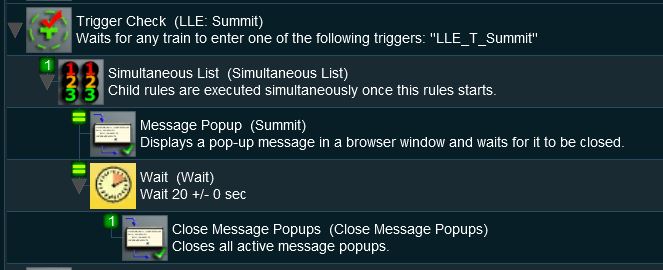How to Use Message Popup Rule (Applications)
From TrainzOnline
(Difference between revisions)
(Timed Message Example added) |
m |
||
| Line 22: | Line 22: | ||
</table> | </table> | ||
*'''Line 1: Trigger Check''' The event is triggered when a consist passes over a track trigger but any event could be used, such as a '''Navigation Point''', a '''TimeCheck''', a '''Wait On ...''' or '''Wait For ...''', etc. As long as the following rules are child rules of the trigger event. | *'''Line 1: Trigger Check''' The event is triggered when a consist passes over a track trigger but any event could be used, such as a '''Navigation Point''', a '''TimeCheck''', a '''Wait On ...''' or '''Wait For ...''', etc. As long as the following rules are child rules of the trigger event. | ||
| − | *'''Line 2: Simultaneous List''' This forces all the following child rules to be executed at the same time. Events such as the '''Trigger Check''' that execute their child rules in order would not work in this example because everything else would be forced to wait until the '''Message Popup''' has been closed. Events that execute their child rules simultaneously would not need the Simultaneous List Rule. | + | *'''Line 2: Simultaneous List''' This forces all the following child rules to be executed at the same time. Events such as the '''Trigger Check''' that execute their child rules in order would not work in this example because everything else would be forced to wait until the '''Message Popup''' has been closed. Using the '''Simultaneous List Rule''' avoids this problem. Events that execute their child rules simultaneously would not need the Simultaneous List Rule. |
*'''Line 3: Message Popup''' This places the message window in the screen and waits for it to be closed either manually (by the user) or by another rule. | *'''Line 3: Message Popup''' This places the message window in the screen and waits for it to be closed either manually (by the user) or by another rule. | ||
*'''Line 4: Wait''' This forces a wait for a set time period, in this case 20 seconds but any time interval can be set. At the end of that period the rule will then execute its own set of child rules. The '''Wait Rule''' executes its child rules in order but as there is only one child rule this does not matter. | *'''Line 4: Wait''' This forces a wait for a set time period, in this case 20 seconds but any time interval can be set. At the end of that period the rule will then execute its own set of child rules. The '''Wait Rule''' executes its child rules in order but as there is only one child rule this does not matter. | ||
*'''Line 5: Close Message Popup''' The message window is closed. | *'''Line 5: Close Message Popup''' The message window is closed. | ||
Revision as of 21:21, 28 April 2018
- The Message Popup Rule is a T:ANE Session Rule that creates onscreen messages for users in Driver Mode.
- The Close Message Popup Rule is a T:ANE Session Rule that closes onscreen messages for users in Driver Mode.
This page gives practical examples of how these rules can be used in a session to create messages that appear after an event, such as a trigger and are automatically closed by another event, such as a set time interval.
Timed Message Example
In this example, a Message Popup is activated by a triggered event and the message is automatically closed after a set time interval.
Rules Used:
- Trigger Check Rule to trigger the message event.
- Simultaneous List Rule to force all child rules to be executed at the same time.
- Message Popup Rule to open a message window on the screen.
- Wait Rule to wait a set time interval.
- Close Message Popup Rule to close the message window.
 |
- Line 1: Trigger Check The event is triggered when a consist passes over a track trigger but any event could be used, such as a Navigation Point, a TimeCheck, a Wait On ... or Wait For ..., etc. As long as the following rules are child rules of the trigger event.
- Line 2: Simultaneous List This forces all the following child rules to be executed at the same time. Events such as the Trigger Check that execute their child rules in order would not work in this example because everything else would be forced to wait until the Message Popup has been closed. Using the Simultaneous List Rule avoids this problem. Events that execute their child rules simultaneously would not need the Simultaneous List Rule.
- Line 3: Message Popup This places the message window in the screen and waits for it to be closed either manually (by the user) or by another rule.
- Line 4: Wait This forces a wait for a set time period, in this case 20 seconds but any time interval can be set. At the end of that period the rule will then execute its own set of child rules. The Wait Rule executes its child rules in order but as there is only one child rule this does not matter.
- Line 5: Close Message Popup The message window is closed.